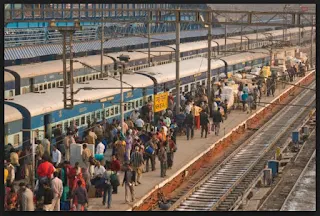Larger cities are often seen as concentrations of social problems, poverty and high unemployment rates. Thus an interesting question is why do people move to cities? Contemporary migration in developing countries arises from the attraction of the city as compared to the rural areas from which migrants move. Migrants are attracted by better access to public services such as electricity, clinics, schools, as well as better prospects for recreation in cities. Thus, the ‘bright lights’ of the cities may be a pulling factor.
However, although some migrants move for these reasons, numerous studies show that migrants respond primarily to economic incentives. People move from poorer areas to wealthier areas for economic gain. Differences in average income or wage levels between rural and urban areas significantly affect migration between two locations. Economic research supports this. According to the World Bank, the urban-rural wage gap is huge in developing countries. An urban construction worker in Côte d'Ivoire earns 8.8 times the rural wage rate and an urban steel worker in India earns 8.4 times the rural wage in that country. Wages are, in turn, kept high in cities by union pressure, by strict application of minimum wage laws or by the payment of relatively high wages by government and foreign corporations. Thus, rural-urban migration is an example of labour market adjustment.
If economic factors play a critical role in determining rural-urban migration, then urbanisation and city growth are clearly determined by those same factors. It follows that urbanisation and city growth cannot be analysed without giving explicit attention to the interaction between rural and labour markets. To understand the process of urbanisation consider Figure 3 which shows two labour markets where (a) is rural and (b) is urban. In these markets, equilibrium wages are determined by the demand for and supply of rural and urban workers. In equilibrium, the rural wage will be equal to the urban wage since workers would move between the two markets until the equilibrium wage is reached (we). In equilibrium, LA is the number of workers employed in the rural market and Lu is the number of workers employed in the urban market.
However, government intervention in the form of minimum wage laws is a common feature of urban labour markets in developing countries. Thus, wages are pushed up and kept above the equilibrium level (w*). At the higher-than-equilibrium wage rate in the urban labour market, firms demand less labour (OLd) but more workers wish to work (OLs) and there will be excess supply of workers (LdLs). In other words, the minimum wage will restrict the creation of jobs by LuLd and increase the size of the urban labour force (LuLs) as more workers leave the rural sector attracted by the higher wage in the urban market. The incentive to stay in the urban area is that a worker improves his prospects of high-wage employment but at the risk of being unemployed.
The urban labour market is therefore like a lottery: a worker buys a ticket (i.e. goes to the city) in the hope of hitting the jackpot (i.e. getting a high-wage job). As with all lotteries, most people lose. Those who seek a job in the high-wage sector but end up unemployed have three options:
· return to the villages whence they came;
· stay and contribute to urban unemployment;
· settle for a low-wage job while waiting for the jackpot.
It seems that the majority of migrants stay.
Evidence shows that rural workers migrate to the cities even if they are unlikely to find jobs, provided that they expect to hit the jackpot eventually by obtaining high-wage sector employment. The incentive to wait is the large difference between urban and rural wages. Migrants are attracted to the cities, not because they are assured of an increase in wages, but because they gamble on being absorbed in high-wage employment and are willing to be unemployed or accept very low wages in the urban labour market for a period of time in the expectation of achieving a high lifetime income. However, the chances of hitting the jackpot fall as more and more rural workers join the ranks of the unemployed. At some point the unemployed are numerous enough to discourage additional migration in excess of the rate at which new jobs were being created in the high-wage sector, In this way, urban unemployment acts as an equilibrium device, eventually choking off the flow of new migrants.
Who migrates?
If economic forces are so important in influencing m8igration, then we would expect that the people who choose to migrate will be those with most to gain from it. In all developing countries, migration is concentrated in the 15-30 age group, with a substantial portion in the 15-24 sub-group. This accords well with the view that economic factors explain rural-urban explanation because the lifetime income gains are largest for the young. Evidence from most countries show that the probability of migration is generally also higher for the more educated. In Colombia, for example, the migration rate is four times as high for those with higher education as for those with none. Earlier migration surveys describe the typical rural-urban migrant as young and better educated than the average rural resident. It is also known that migrants tend to move to places with higher income and employment levels than their origin locations and that friends and relatives in the destination area increase the attraction of the location, while distance between two locations reduces the attraction.
by Shashikant Nishant Sharma











